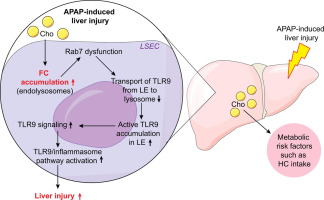当前位置:
X-MOL 学术
›
J. Hepatol.
›
论文详情
Our official English website, www.x-mol.net, welcomes your feedback! (Note: you will need to create a separate account there.)
Free cholesterol accumulation in liver sinusoidal endothelial cells exacerbates acetaminophen hepatotoxicity via TLR9 signaling
Journal of Hepatology ( IF 25.7 ) Pub Date : 2017-10-01 , DOI: 10.1016/j.jhep.2017.05.020 Toshiaki Teratani , Kengo Tomita , Takahiro Suzuki , Hirotaka Furuhashi , Rie Irie , Shigeaki Hida , Yoshikiyo Okada , Chie Kurihara , Hirotoshi Ebinuma , Nobuhiro Nakamoto , Hidetsugu Saito , Toshifumi Hibi , Soichiro Miura , Ryota Hokari , Takanori Kanai
Journal of Hepatology ( IF 25.7 ) Pub Date : 2017-10-01 , DOI: 10.1016/j.jhep.2017.05.020 Toshiaki Teratani , Kengo Tomita , Takahiro Suzuki , Hirotaka Furuhashi , Rie Irie , Shigeaki Hida , Yoshikiyo Okada , Chie Kurihara , Hirotoshi Ebinuma , Nobuhiro Nakamoto , Hidetsugu Saito , Toshifumi Hibi , Soichiro Miura , Ryota Hokari , Takanori Kanai

|
BACKGROUND & AIMS
Although obesity is a risk factor for acute liver failure, the pathogenic mechanisms are not yet fully understood. High cholesterol (HC) intake, which often underlies obesity, is suggested to play a role in the mechanism. We aimed to elucidate the effect of a HC diet on acetaminophen-induced acute liver injury, the most frequent cause of acute liver failure in the USA. METHODS
C57BL/6 Toll-like receptor 9 (TLR9) knockout (Tlr9-/-) mice and their Tlr9+/+ littermates were fed an HC diet for fourweeks and then treated with acetaminophen. Liver sinusoidal endothelial cells (LSECs) were isolated from the mice for in vivo and in vitro analyses. RESULTS
The HC diet exacerbated acetaminophen-induced acute liver injury in a TLR9/inflammasome pathway-dependent manner. LSECs played a major role in the cholesterol loading-induced exacerbation. The accumulation of free cholesterol in the endolysosomes in LSECs enhanced TLR9-mediated signaling, thereby exacerbating the pathology of acetaminophen-induced liver injury through the activation of the TLR9/inflammasome pathway. The accumulation of free cholesterol in LSEC endolysosomes induced a dysfunction of the Rab7 membrane trafficking recycling mechanism, thus disrupting the transport of TLR9 from late endosomes to the lysosomes. Consequently, the level of active TLR9 in the late endosomes increased, thereby enhancing TLR9 signaling in LSECs. CONCLUSIONS
HC intake exaggerated acetaminophen-induced acute liver injury via free cholesterol accumulation in LSECs, demonstrating a novel role of free cholesterol as a metabolic factor in TLR9 signal regulation and pathologies of acetaminophen-induced liver injury. Therapeutic approaches may target this pathway. Lay summary: High cholesterol intake exacerbated acetaminophen-induced acute liver injury via the accumulation of free cholesterol in the endolysosomes of liver sinusoidal endothelial cells. This accumulation enhanced Toll-like receptor 9 signaling via impairment of its membrane trafficking mechanism. Thus, free cholesterol accumulation, as an underlying metabolic factor, exacerbated the pathology of acetaminophen-induced liver injury through activation of the TLR9/inflammasome pathway.
中文翻译:

肝窦内皮细胞中游离胆固醇的积累通过 TLR9 信号加剧了对乙酰氨基酚的肝毒性
背景与目的虽然肥胖是急性肝功能衰竭的危险因素,但其发病机制尚未完全了解。高胆固醇 (HC) 摄入量通常是肥胖的基础,被认为在该机制中起作用。我们旨在阐明 HC 饮食对对乙酰氨基酚引起的急性肝损伤的影响,这是美国急性肝衰竭的最常见原因。方法 C57BL/6 Toll 样受体 9 (TLR9) 敲除 (Tlr9-/-) 小鼠和它们的 Tlr9+/+ 同窝小鼠被喂食 HC 饮食 4 周,然后用对乙酰氨基酚处理。从小鼠中分离肝窦内皮细胞 (LSEC) 用于体内和体外分析。结果 HC 饮食以 TLR9/炎性体通路依赖性方式加剧了对乙酰氨基酚诱导的急性肝损伤。LSEC 在胆固醇负荷诱导的恶化中起主要作用。LSECs内溶酶体中游离胆固醇的积累增强了TLR9介导的信号传导,从而通过激活TLR9/炎症小体途径加剧了对乙酰氨基酚诱导的肝损伤的病理学。LSEC 内溶酶体中游离胆固醇的积累导致 Rab7 膜运输循环机制的功能障碍,从而破坏了 TLR9 从晚期内体到溶酶体的转运。因此,晚期内体中活性 TLR9 的水平增加,从而增强了 LSEC 中的 TLR9 信号传导。结论 HC 摄入通过 LSEC 中游离胆固醇的积累加剧了对乙酰氨基酚引起的急性肝损伤,证明游离胆固醇作为代谢因子在 TLR9 信号调节和对乙酰氨基酚诱导的肝损伤病理中的新作用。治疗方法可能针对这一途径。总结:高胆固醇摄入会通过肝窦内皮细胞内溶酶体中游离胆固醇的积累加剧对乙酰氨基酚引起的急性肝损伤。这种积累通过破坏其膜运输机制增强了 Toll 样受体 9 信号。因此,游离胆固醇积累作为潜在的代谢因素,通过激活 TLR9/炎症小体途径加剧了对乙酰氨基酚诱导的肝损伤的病理学。高胆固醇摄入量通过肝窦内皮细胞内溶酶体中游离胆固醇的积累加剧了对乙酰氨基酚引起的急性肝损伤。这种积累通过破坏其膜运输机制增强了 Toll 样受体 9 信号。因此,游离胆固醇积累作为潜在的代谢因素,通过激活 TLR9/炎症小体途径加剧了对乙酰氨基酚诱导的肝损伤的病理学。高胆固醇摄入量通过肝窦内皮细胞内溶酶体中游离胆固醇的积累加剧了对乙酰氨基酚引起的急性肝损伤。这种积累通过破坏其膜运输机制增强了 Toll 样受体 9 信号。因此,游离胆固醇积累作为潜在的代谢因素,通过激活 TLR9/炎症小体途径加剧了对乙酰氨基酚诱导的肝损伤的病理学。
更新日期:2017-10-01
中文翻译:

肝窦内皮细胞中游离胆固醇的积累通过 TLR9 信号加剧了对乙酰氨基酚的肝毒性
背景与目的虽然肥胖是急性肝功能衰竭的危险因素,但其发病机制尚未完全了解。高胆固醇 (HC) 摄入量通常是肥胖的基础,被认为在该机制中起作用。我们旨在阐明 HC 饮食对对乙酰氨基酚引起的急性肝损伤的影响,这是美国急性肝衰竭的最常见原因。方法 C57BL/6 Toll 样受体 9 (TLR9) 敲除 (Tlr9-/-) 小鼠和它们的 Tlr9+/+ 同窝小鼠被喂食 HC 饮食 4 周,然后用对乙酰氨基酚处理。从小鼠中分离肝窦内皮细胞 (LSEC) 用于体内和体外分析。结果 HC 饮食以 TLR9/炎性体通路依赖性方式加剧了对乙酰氨基酚诱导的急性肝损伤。LSEC 在胆固醇负荷诱导的恶化中起主要作用。LSECs内溶酶体中游离胆固醇的积累增强了TLR9介导的信号传导,从而通过激活TLR9/炎症小体途径加剧了对乙酰氨基酚诱导的肝损伤的病理学。LSEC 内溶酶体中游离胆固醇的积累导致 Rab7 膜运输循环机制的功能障碍,从而破坏了 TLR9 从晚期内体到溶酶体的转运。因此,晚期内体中活性 TLR9 的水平增加,从而增强了 LSEC 中的 TLR9 信号传导。结论 HC 摄入通过 LSEC 中游离胆固醇的积累加剧了对乙酰氨基酚引起的急性肝损伤,证明游离胆固醇作为代谢因子在 TLR9 信号调节和对乙酰氨基酚诱导的肝损伤病理中的新作用。治疗方法可能针对这一途径。总结:高胆固醇摄入会通过肝窦内皮细胞内溶酶体中游离胆固醇的积累加剧对乙酰氨基酚引起的急性肝损伤。这种积累通过破坏其膜运输机制增强了 Toll 样受体 9 信号。因此,游离胆固醇积累作为潜在的代谢因素,通过激活 TLR9/炎症小体途径加剧了对乙酰氨基酚诱导的肝损伤的病理学。高胆固醇摄入量通过肝窦内皮细胞内溶酶体中游离胆固醇的积累加剧了对乙酰氨基酚引起的急性肝损伤。这种积累通过破坏其膜运输机制增强了 Toll 样受体 9 信号。因此,游离胆固醇积累作为潜在的代谢因素,通过激活 TLR9/炎症小体途径加剧了对乙酰氨基酚诱导的肝损伤的病理学。高胆固醇摄入量通过肝窦内皮细胞内溶酶体中游离胆固醇的积累加剧了对乙酰氨基酚引起的急性肝损伤。这种积累通过破坏其膜运输机制增强了 Toll 样受体 9 信号。因此,游离胆固醇积累作为潜在的代谢因素,通过激活 TLR9/炎症小体途径加剧了对乙酰氨基酚诱导的肝损伤的病理学。



























 京公网安备 11010802027423号
京公网安备 11010802027423号